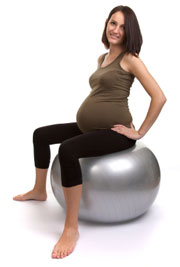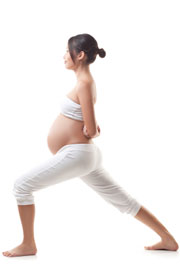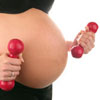- Introduction to exercise during pregnancy
- Body changes during pregnancy
- Exercise frequency and intensity during pregnancy
- Appropriate physical activities during pregnancy
- Exercises to avoid during pregnancy
Introduction to exercise during pregnancy

There are some general guidelines which outline which exercises are recommended for pregnant women but the appropriateness of these activities will be largely determined by pre-pregnancy fitness level and previous exercise experience as this will dictate what intensity, frequency and type of activity can be safely maintained by each individual during pregnancy.
Body changes during pregnancy

There is a significant increase in body weight during pregnancy that can make jogging and running uncomfortable. The change in body weight and weight distribution can alter balance and coordination making sports that require these skills challenging and even dangerous.
The ligaments and joints around the pelvic region will begin to loosen up as the pregnancy progresses in order to prepare the body for labour. For this reason activities which may impose a risk of injury in this area should be avoided. This is anything that requires quick changes of direction, jumping and jerky movements.
Physiologically, the increase in resting heart rate associated with pregnancy necessitates that women do not over exert themselves.
The decrease in blood pressure which occurs in pregnancy may also make some women light-headed and dizzy meaning that activities involving balance may be difficult.
Exercise frequency and intensity during pregnancy
It is recommended that pregnant women, with what is considered as a low risk pregnancy, engage in moderate intensity exercise for 30 minutes a day, 4 times a week. Low risk pregnancies are those which are not otherwise constrained by medical or obstetric complications.
Depending on the woman’s individual medical history and exercise experience, the exercise program will need to be initiated differently. Your doctor can help you with this.
More information on Beginning an Exercise Program During Pregnancy.
What is classed as “moderate” intensity exercise is subjective and will be quite different depending on individual fitness levels. A good way to determine a comfortable intensity while exercising is through the talk test. If you cannot maintain a conversation during exercise then this is not considered to be moderate intensity and you should reduce the intensity of your physical activity until you can.
Book your health appointments online
Find and instantly book your next health appointment with Healthengine
Appropriate physical activities during pregnancy
Appropriate physical activities to engage in during pregnancy are quite common sense. Any activities that have a low risk of falling, injury and joint and ligament damage should be chosen. This includes low impact activities that do not require too many quick changes to the centre of gravity or depend predominantly on balance.

For more information on Warming Up Before Exercise.
Walking is the most common exercise amongst pregnant women. Walking is safe for everyone, including pregnant women who are only just beginning to exercise. Walking has a low risk of falls and it is easy to control exertion levels. Brisk walking is low impact for joints and muscles yet still gives a total body workout and improves cardiovascular fitness.
Some water sports such as swimming, water aerobics and water walking are safe and fun sports.
Swimming works almost all muscles in the body without the risk of overheating. Water aerobics is great for cardiovascular fitness. These water sports are safe as there is no risk of falling or losing balance and the water supports body weight so the risk of muscle strain is low.
Water activities are especially effective for women who experience back pain and leg swelling during pregnancy as it has been found to alleviate these symptoms.
Cycling is another good cardiovascular workout that will help improve leg muscle strength. During pregnancy stationary cycling is a better alternative because as your belly grows, especially in the third trimester, balance on a bike will be difficult.

Studies have shown that there are benefits from engaging in weight training while pregnant. Improvements in strength and flexibility have been noted. This is turn will help the body adapt to the physiological changes that occur during pregnancy. Women may find they can tolerate their heavier body weight and altered centre of gravity better with muscle strengthening that is gained from training, especially focussing on lower back strength.
Running is safe in moderation for women that were running frequently before they became pregnant. It is not advised that women that have never run before take up running during their pregnancy. Depending on the individual, the running regime may need to lessen in intensity and frequency.
Exercises to avoid during pregnancy
While frequent moderate intensity exercise is safe and recommended for pregnant women there are some sports that will increase the risks of injury, stress and other complications. Some activities will simply be too uncomfortable or tiring. It is important that women who are planning to exercise while they are pregnant are aware of what exercises they should avoid including:
Heavy weight training lifts that involve maximal isometric muscle contractions are thought to put too much stress on the cardiovascular and musculoskeletal system;
- Holding your breath during difficult positions during yoga or while weight training. If you are ever not breathing during any exercise this is a clear indication you are over-exerting yourself and you need to stop immediately;
- Exercises lying on your back after the first trimester of pregnancy should be avoided to reduce the risk of affecting blood flow to the foetus and hypotension from vena cava compression by the uterus;
- Exercises which involve lying on the stomach;
- Some abdominal strengthening exercises will be very uncomfortable due to muscle weakness and the development of abdominal seperation, a condition where called diastasis recti. This occurs as a result of the growing uterus;
- Standing still for long periods of time is not recommended;
- Contact sports and high-impact sports such as ice hockey, soccer and basketball can risk abdominal trauma, excessive joint stress and falls;
- Scuba diving should be avoided as the pressure can result in birth defects and foetal decompression sickness;
- Any activities that increase the risk of falls should be avoided in order to reduce the risk of injury to you and your foetus. This includes sports such as gymnastics, horseback riding and water skiing;
- Any activities which require changes to the centre of gravity should be avoided as this can cause balance problems. This includes vigorous racquet sports such as squash and tennis;
- Any sports at altitude may induce altitude sickness which in turn can reduce the oxygen supply to the foetus. This does not appear to be the case for moderate intensity exercise at altitudes anywhere up to 2,500m but if you want to exercise at altitudes above this upper limit you should be guided through appropriate acclimatisation and make modifications to you activities as guided by your doctor. If you experience symptoms of altitude sickness including excessive shortness of breath, chest pain and light-headedness and weakness, you must stop exercising immediately and seek medical aid.
More information
 |
For more information about pregnancy and exercise, including pre-pregnancy exercise, suitable types of exercise, risks and benefits of exercise and exercise myths, see Pregnancy and Exercise. |
 |
For more information about pregnancy, including preconception advice, stages of pregnancy, investigations, complications, living with pregnancy and birth, see Pregnancy. |
 |
For more information on fitness and exercise, including stretches, types of exercise, exercise recovery and exercise with health conditions, as well as some useful videos, see Fitness. |
References
- National Collaborating Centre for Women’s and Children’s Health. Antenatal care: routine care for the healthy pregnant woman. Clinical Guideline March 2008 2nd ed. RCOG Press; London: 2008. [Full Text]
- Sydney South West Academy of Sport Policy Statement: Exercise During Pregnancy [online]. SWSAS [cited June 2010]. Available from: URL: http://www.swsas.org.au/documents/pregnancy%20and%20sport%20policy.pdf
- Davies GAL, Wolfe LA, Mottola MF, MacKinnon C. Exercise in pregnancy and the postpartum period. Joint SOGC/CSEP Clinical Practice Guideline. 2003; 129: 1 – 7. [Full Text]
- The Royal Australian and New Zealand College of Obstetricians and Gynaecologists. Endorsed statements [online]. Pregnancy in Sport – Guidelines for the Australian Sporting Committee, 2002 [cited Apr 2010]. Available from: URL: http://www.ranzcog.edu.au/womenshealth/endorsedstatements.shtml
- Mottola M. Exercise Prescription for Overweight and Obese Women: Pregnancy and Postpartum. Obstet Gynecol Clin N Am. 2009; 36: 301–16. [Full text]
- Gavard JA, Artal R. Effect of exercise on pregnancy outcome. Clin Obs Gynecol. 2008; 51(2): 467–80. [Abstract]
- Nutrition Australia: Physical Activity During Pregnancy [online]. Sports Nutition 2010 [cited June 2010]. Available from: URL: http://www.nutritionaustralia.org/national/resources
- American Congress of Obstetricians and Gynecologists: Exercise during pregnancy [online]. ACOG 2003 [cited June 2010]. Available: URL: http://www.acog.org/publications/patient_education/bp119.cfm
- Sleeping positions during pregnancy [online]. American pregnancy association, 2010 [cited July 2010]. Available from URL: http://www.americanpregnancy.org/pregnancyhealth/sleepingpositions.html
All content and media on the HealthEngine Blog is created and published online for informational purposes only. It is not intended to be a substitute for professional medical advice and should not be relied on as health or personal advice. Always seek the guidance of your doctor or other qualified health professional with any questions you may have regarding your health or a medical condition. Never disregard the advice of a medical professional, or delay in seeking it because of something you have read on this Website. If you think you may have a medical emergency, call your doctor, go to the nearest hospital emergency department, or call the emergency services immediately.

 Heavy weight training lifts that involve maximal
Heavy weight training lifts that involve maximal 





